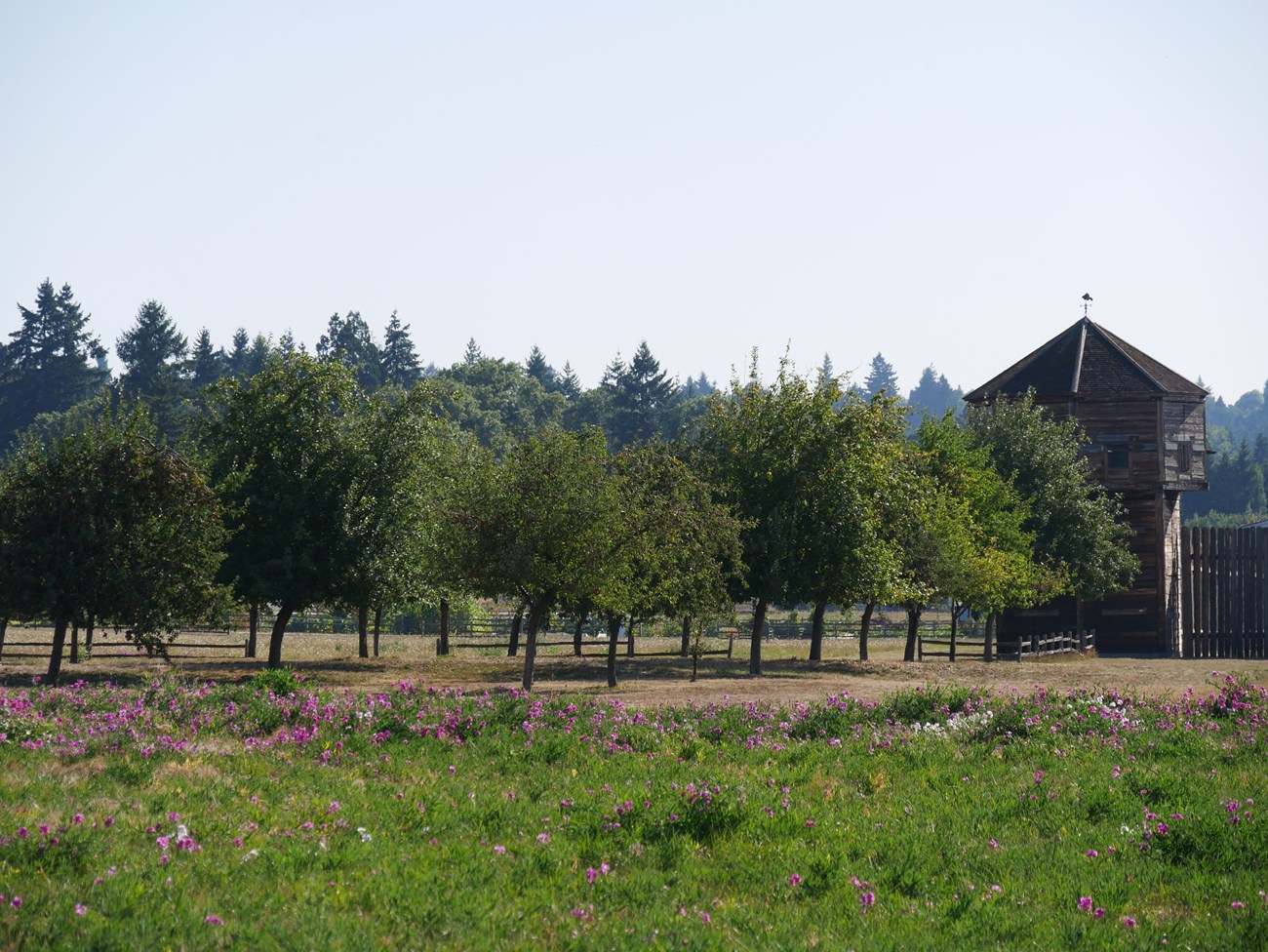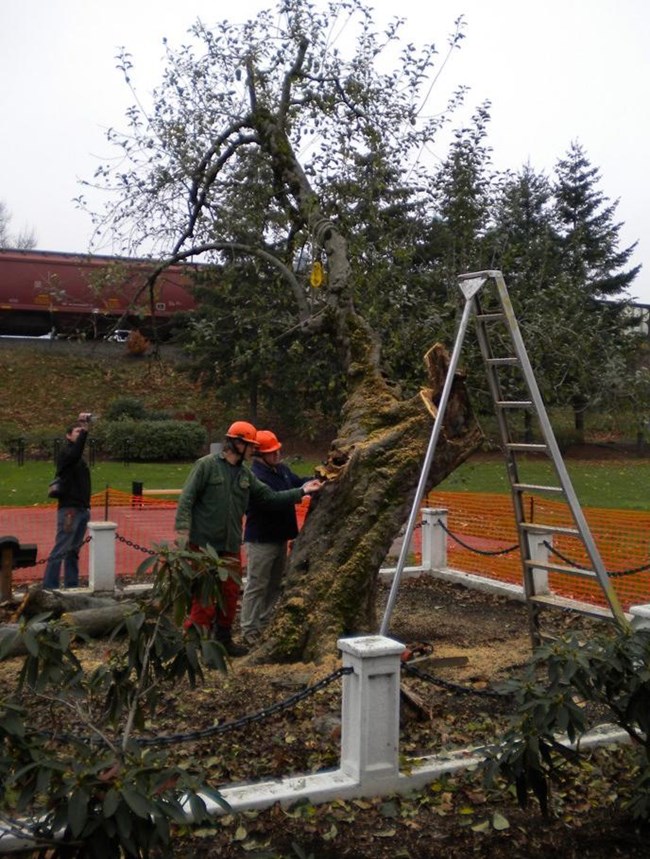Last updated: April 7, 2023
Article
Requiem for the 1820s Fort Vancouver Apple Tree, and a New Dawn

NPS
The venerable “Old Apple Tree” of Fort Vancouver, Washington has died. With sadness, Charles Ray, Urban Forester with the City of Vancouver announced that the tree had succumbed to mortality on June 25, 2020. The nearly 200-year old tree was a local landmark and the oldest living feature associated with Fort Vancouver, first celebrated in The Morning Oregonian in 1911. Few apple trees in the United States have graced the earth longer than this tree. Recognized as the oldest apple tree in the Pacific Northwest, its longevity derived from its anatomy as a seedling tree that grew upon its own roots, as well as from the particular robustness of its genes.
By 1827, when the Old Apple Tree’s seed is thought to have germinated, apple trees throughout the world had been propagated for more than 2000 years by grafting. It was well-recognized that some trees produced exceptional fruit, and their uniqueness or “variety” could only be reproduced by grafting. In grafting, a form of vegetative propagation, variety trees are joined to the roots of a different, more durable tree, the rootstock. Grafting reproduces the variety but inadvertently shortens the natural lifespan.
By 1827, when the Old Apple Tree’s seed is thought to have germinated, apple trees throughout the world had been propagated for more than 2000 years by grafting. It was well-recognized that some trees produced exceptional fruit, and their uniqueness or “variety” could only be reproduced by grafting. In grafting, a form of vegetative propagation, variety trees are joined to the roots of a different, more durable tree, the rootstock. Grafting reproduces the variety but inadvertently shortens the natural lifespan.

Created by Gustav Sohon, NPS/Fort Vancouver National Historic Site Archives
As the apple seedling anchored its roots in the New World, its location north of the Columbia River was occupied by the Hudson’s Bay Company (HBC), a Royal-chartered fur-trading corporation of Great Britain. The seed may have been transported on the 17,000-mile sea voyage from England by Captain Æmilius Simpson, a cousin of HBC Governor-in-Chief George Simpson, head of the HBC’s North American operations. Æmilius reportedly carried seed in his vest pocket for planting in a country where apples were unknown.

NPS

Oregon Historical Society
As the Army burned or demolished traces of the HBC in building a military reservation, remarkably, the Old Apple Tree escaped the axe. The tree saw the first US Army post in the Pacific Northwest serve as a major headquarters and supply depot during the Civil War and Indian War eras, and as a training post during the Spanish-American War. In 1906, it survived the completion of the nearby Spokane, Portland & Seattle Railroad, and in 1911 was recognized with a commemorative plaque, declaring it the “Oldest Apple Tree in the Northwest”. During World War I, the apple tree flourished near the world’s largest lumber mill that turned spruce timber into boards for military aircraft. By 1920, the Army had installed an elegant, protective railing, potentially in response to burgeoning development in the vicinity.

Courtesy of The Columbian
In the 1980s, when major state and interstate highway construction threatened impacts, the Old Apple Tree was duly considered, along with nearby archeological resources. Plans led to extensive archeological investigations in the former Fort Vancouver employee village area, and the creation of a pocket park around the Old Apple Tree known as “Old Apple Tree Park”. The park has since been the venue of the Old Apple Tree Festival every October, in celebration of the tree. Over the years, cuttings have been shared at the festival, with some taking root in neighborhood yards.
At the turn of the 21st-century, the National Park Service and the City of Vancouver partnered with the National Clonal Germplasm Repository in Corvallis, Oregon, to clone the Old Apple Tree and conserve its germplasm in perpetuity. Clone trees were propagated from rooted cuttings and planted out within a reconstructed HBC orchard as part of the NPS fort reconstruction efforts. Since their planting in 2004, the clone trees have far exceeded the vigor of other young apple trees in the orchard that were derived from the seeds of old English cider varieties.
The Old Apple Tree clones that form the first orchard row nearest the stockade were quicker to establish and more resilient from the start. Clearly, the genes of the Old Apple Tree were particularly robust. A volunteer’s recent efforts in genetic testing in collaboration with Washington State University and the University of Wisconsin have indicated a potential connection with the French variety Reinette Franche, originated in the 1500s.

NPS

NPS
Despite a huge reduction in the canopy, and the fragility of the now almost-hollow trunk, the Old Apple Tree responded with some new aerial growth and suckered from the roots. Arborists stepped up their regular maintenance to shape a smaller canopy and reduce the wind-sail effect. Some rootsuckers were protected and allowed to form branches, becoming replacement trees in-waiting.
The Old Apple Tree held on for another 11 years until late June 2020, when part of the trunk gave way, causing the canopy to desiccate. The young rootsucker trees were unaffected, however, and are now ready to supersede their progenitor. While the young trees currently lack the stature and character of the Old Apple Tree, in having the same genetic makeup they do, in fact, embody the Old Apple Tree.

Courtesy of City of Vancouver
Discover More
- Fort Vancouver Cultural Landscape Inventory report (2009)
- Vancouver National Historic Reserve Cultural Landscape Report (2005)
- Fruitful Legacy: A Historic Context of Orchards in the United States, with Technical Information for Registering Orchards in the National Register of Historic Places
- Fort Vancouver National Historic Site park website
- City of Vancouver: Old Apple Tree Park
- An introduction to bridge grafting
- More about NPS cultural landscapes
